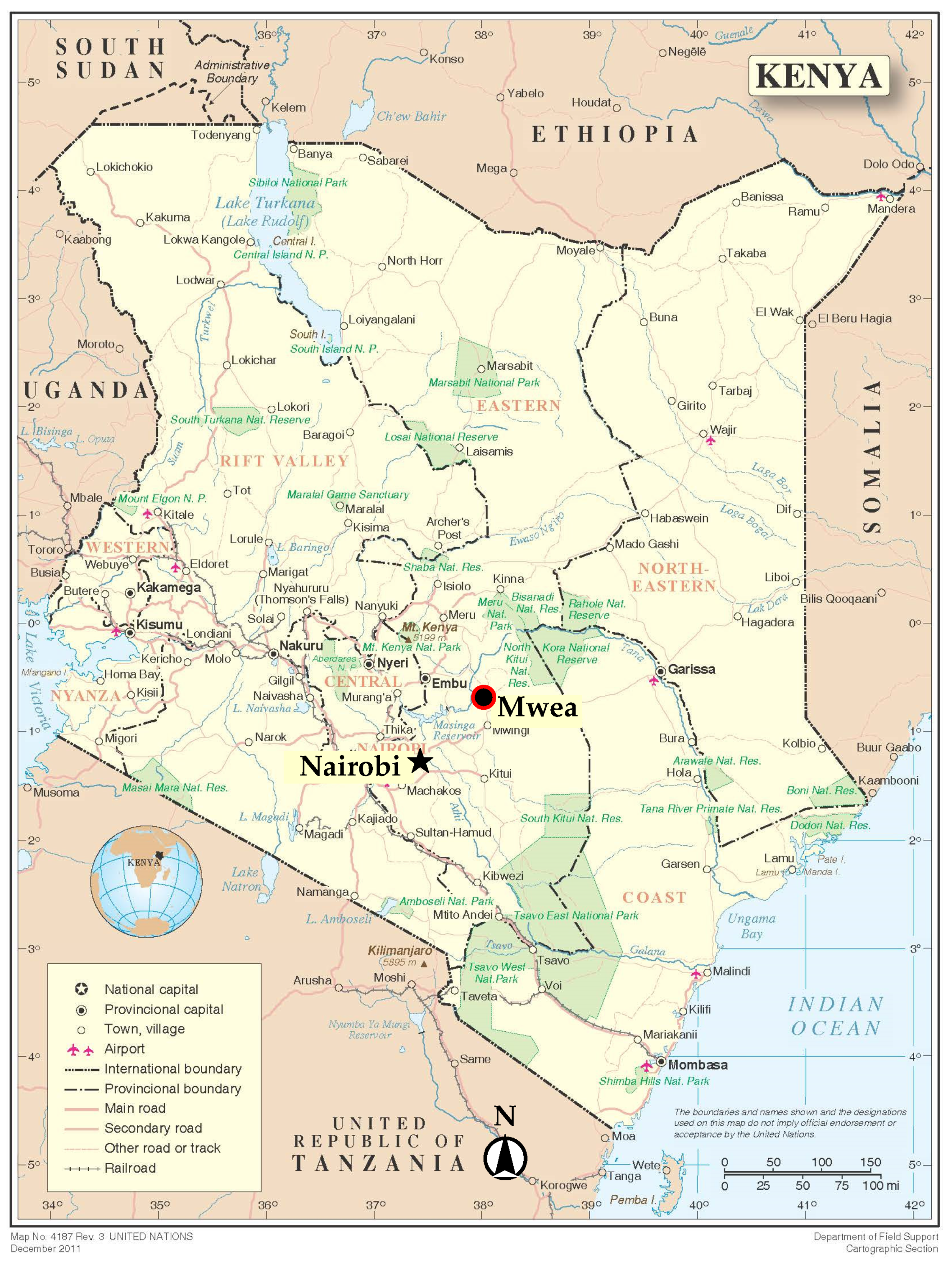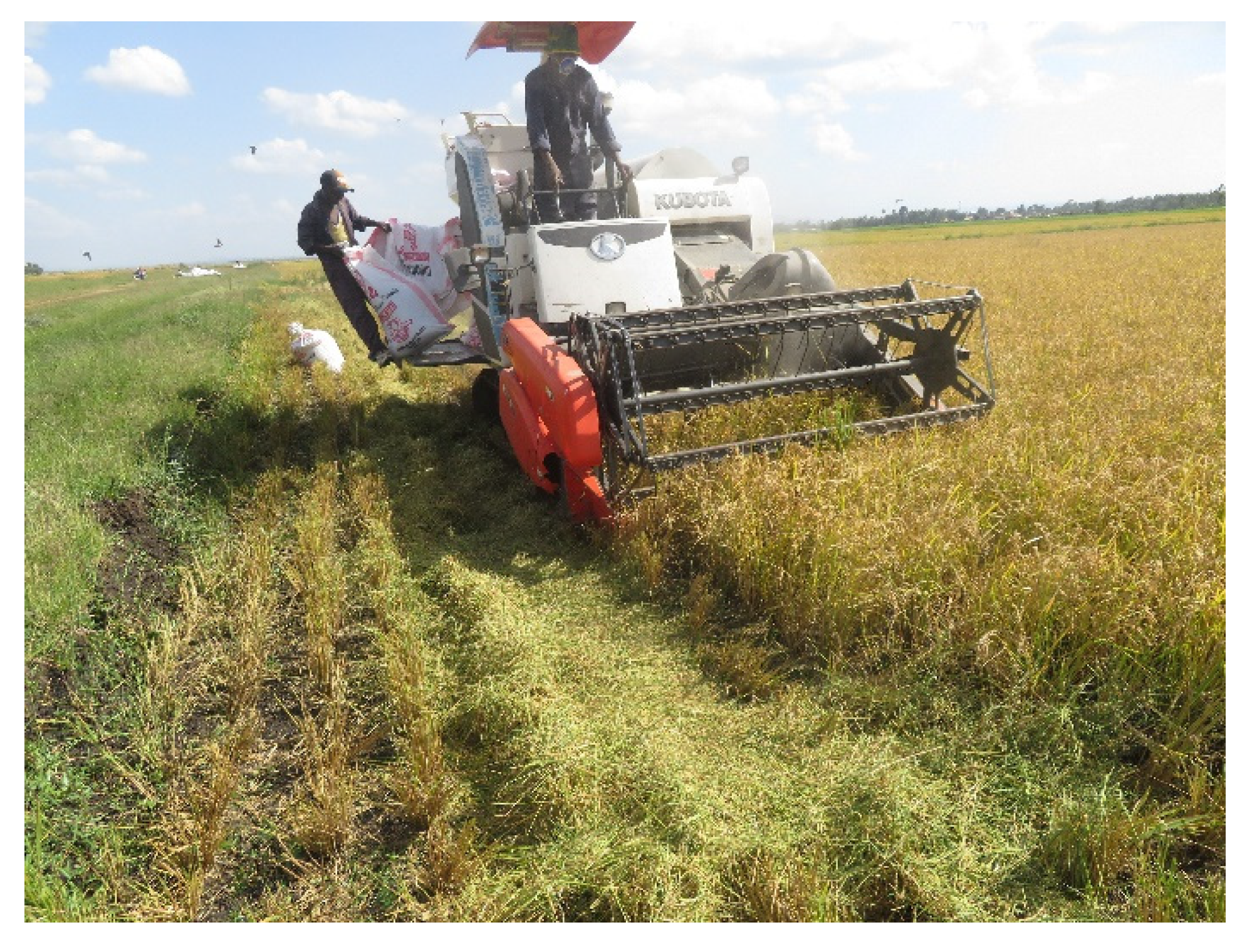Production Costs and Benefits of Japonica Rice in Mwea, Kenya
Abstract
:1. Introduction
2. Materials and Methods
2.1. Study Area
2.2. Japonica Rice Production Stage Cost and Benefit Calculation
3. Results and Discussion
3.1. Experimental Cultivation of Japonica Rice
3.1.1. Total Yield and Unit Yield
3.1.2. Production Stage Cost–Benefit Analysis
4. Conclusions
Author Contributions
Funding
Institutional Review Board Statement
Informed Consent Statement
Acknowledgments
Conflicts of Interest
References
- Ministry of Agriculture, Livestock and Fisheries, Government of Kenya. National Rice Development Strategy (2008–2013) Revised Edition 2014; Ministry of Agriculture, Livestock and Fisheries, Government of Kenya: Nairobi, Kenya, 2014; pp. 1–44.
- Atera, E.A.; Onyancha, F.N.; Majiwa, E.B.O. Production and marketing of rice in Kenya: Challenges and opportunities. J. Dev. Agric. Econ. 2018, 10, 64–70. [Google Scholar]
- Ndirangu, S.N.; Oyange, W.A. Analaysis of Millers in Kenya’s Rice Value Chain. IOSR J. Agric. Vet. Sci. (IOSR-JAVS) 2019, 12, 38–47. [Google Scholar]
- USDA_PS&D Online, PSD Data Sets, Last Updated Aug/12/2020. Available online: https://apps.fas.usda.gov/psdonline/app/index.html#/app/downloads (accessed on 13 August 2020).
- Muhunyu, J.G. Is Doubling Rice Production in Kenya by 2018 Achievable? J. Dev. Sustain. Agric. 2012, 7, 46–54. [Google Scholar]
- Mwangi, M.K. Transformation in Mwea Rice Sector. Available online: https://www.maff.go.jp/primaff/koho/seminar/2017/attach/pdf/171030_03.pdf (accessed on 1 November 2017).
- Oyange, W.A.; Chemining’wa, G.N.; Kanya, J.I.; Njiruh, P.N. Azolla Fern in Mwea irrigation scheme and its potential nitrogen contribution in paddy rice production. J. Agric. Sci. 2019, 11, 30–44. [Google Scholar] [CrossRef] [Green Version]
- Narita, D.; Sato, I.; Ogawada, D.; Matsumura, A. Integrating economic measures of adaption effectiveness into climate change interventions: A case study of irrigation development in Mwea, Kenya. PLoS ONE 2020, 15, e0243779. [Google Scholar] [CrossRef]
- Kondo, M.; Ota, T.; Wanjogu, R. Physical and chemical properties of Vertisols and soil nutrient management for intensive rice cultivation in the Mwea area in Kenya. Jpn. J. Trop. Agr. 2001, 45, 126–132. [Google Scholar]
- Tomizuka, T.; Mwithia, D.; Koskei, V. Secondary horticultural cropping in a paddy field in the Mwea irrigation scheme, Kenya: Different drainage techniques and effect on selected crop yields. Trop. Agr. Develop. 2019, 63, 61–68. [Google Scholar]
- Japan International Cooperation Agency, [Singing of a Yen Loan Agreement for the Republic of Kenya (17 August 2010)] Kenya Kyowakoku Muke Ensyakkan Kashitsuke no Choin. Available online: https://www.jica.go.jp/press/2010/20100817_01.html (accessed on 8 April 2020). (In Japanese).
- Samejima, H.; Katsura, K.; Kikuta, M.; Njinju, S.M.; Kimani, J.M.; Yamaguchi, A.; Makihara, D. Analysis of rice yield response to various cropping seasons to develop optimal cropping calendars in Mwea, Kenya. Plant Prod. Sci. 2020, 23, 297–305. [Google Scholar] [CrossRef] [Green Version]
- Kihoro, J.; Bosco, N.J.; Murage, H.; Ateka, E.; Makihara, D. Investigating the impact of rice blast disease on the livelihood of the local farmers in greater Mwea region of Kenya. SpringerPlus 2013, 308, 1–13. [Google Scholar] [CrossRef] [PubMed] [Green Version]
- RiceMAPP, Japan International Cooperation Agency Technical Cooperation Project. Guideline of Water Saving Rice Culture for Mwea Irrigation Scheme Ver.2, Rice Based & Market Oriented Agriculture Promotion Project (RiceMAPP); Japan International Cooperation Agency Technical Cooperation Project: Mwea, Kenya, 2016; pp. 1–30.
- Koskei, V.; Wanjogu, R.; Muthoni, J.; Tomizuka, T.; Goto, A. International Report on Purification and Multiplication of Japonica Rice at MIAD for Commercial Production and Marketing, Rice Based & Market Oriented Agriculture Promotion Project (RiceMAPP); Japan International Cooperation Agency Technical Cooperation Project: Mwea, Kenya, 2016; pp. 1–19.
- Yamada, R. [A study on employment of rice farming labor in Tanzania] Tanzania ni okeru inasaku roudoukoyou ni kansuru kousatsu. Agric. Manag. Res. Nougyou Keiei Kenkyu 1977, 35, 11–23. (In Japanese) [Google Scholar]
- Mofokeng, M.A.; Shargie, N.G. Bird damage and control strategies in grain sorghum production. Int. J. Agric. Environ. Res. 2016, 2, 264–269. [Google Scholar]


| Type of Plot | Area of Plot (ha) | Yield (tons) | Unit Yield (tons/ha) | Average Unit Yield (tons/ha) | Standard Deviation | |
|---|---|---|---|---|---|---|
| S1 | (1) | 0.32 | 2.14 | 6.74 | 6.44 * | 0.82 |
| (2) | 0.32 | 2.34 | 7.43 | |||
| (3) | 0.35 | 1.90 | 5.45 | |||
| S2 | (1) | 0.32 | 1.38 | 4.37 | 3.77 * | 0.45 |
| (2) | 0.31 | 1.14 | 3.64 | |||
| (3) | 0.35 | 1.17 | 3.31 | |||
| Total value or average unit yield | 1.97 | 10.07 | 5.11 | |||
| Japonica Rice | Conventional Rice | |||||
|---|---|---|---|---|---|---|
| S1 | S2 | |||||
| Gross profit | 90.00 | (100) | 90.00 | (100) | 55.00 | (100) |
| Production costs | 28.75 | (32) | 57.23 | (64) | 22.63 | (41) |
| Material costs | 9.39 | (33) | 16.04 | (28) | 9.76 | (43) |
| Labor costs | 19.36 | (67) | 41.19 | (72) | 12.87 | (57) |
| Net profit | 61.25 | (68) | 32.77 | (36) | 32.37 | (59) |
| Japonica Rice | Conventional Rice | |||||
|---|---|---|---|---|---|---|
| S1 | S2 | |||||
| Total material costs | 9.39 | (100) | 16.04 | (100) | 9.76 | (100) |
| Seeds | 0.78 | (8) | 1.33 | (8) | 0.82 | (8) |
| Fertilizer | 3.02 | (32) | 5.15 | (32) | 1.85 | (19) |
| Pesticide | 1.41 | (15) | 2.41 | (15) | 2.24 | (23) |
| Materials | 0.74 | (8) | 1.27 | (8) | 0.72 | (7) |
| Agricultural machinery service charges | 3.45 | (37) | 5.89 | (37) | 4.12 | (42) |
| Japonica Rice | Conventional Rice | |||||
|---|---|---|---|---|---|---|
| S1 | S2 | |||||
| Total labor costs | 19.36 | (100) | 41.19 | (100) | 12.87 | (100) |
| Land preparation | 4.33 | (22) | 7.40 | (18) | 1.54 | (12) |
| Seedbed preparation | 0.41 | (2) | 0.70 | (2) | 0.41 | (3) |
| Transplanting | 3.15 | (16) | 5.38 | (13) | 2.88 | (22) |
| Pesticide application | 0.05 | (0) | 0.08 | (0) | 0.58 | (4) |
| Supplementary planting | 0.09 | (0) | 0.16 | (0) | 0.58 | (4) |
| Fertilizer application | 0.16 | (1) | 0.28 | (1) | 0.29 | (2) |
| Weeding | 3.04 | (16) | 5.19 | (13) | 4.04 | (31) |
| Maintenance and other costs | 7.68 | (40) | 21.23 | (52) | 2.06 | (16) |
| Harvesting | 0.45 | (2) | 0.76 | (2) | 0.49 | (4) |
| Japonica Rice | Conventional Rice | |||||
|---|---|---|---|---|---|---|
| S1 | S2 | |||||
| Total maintenance and other costs | 7.68 | (100) | 21.23 | (100) | 2.07 | (100) |
| Levee maintenance | 0.16 | (2) | 0.28 | (1) | 1.25 | (60) |
| Water canal cleaning | 0.11 | (1) | 0.19 | (1) | ||
| Night watering | 0.92 | (12) | 1.58 | (7) | ||
| Bird scaring | 6.48 | (84) | 19.18 | (90) | 0.28 | (40) |
| Japonica Rice | Conventional Rice | |||||
|---|---|---|---|---|---|---|
| S1 | S2 | |||||
| Gross profit | 90.00 | (100) | 90.00 | (100) | 55.00 | (100) |
| Production costs | 24.46 | (27) | 39.38 | (44) | 22.63 | (41) |
| Material costs | 9.96 | (41) | 16.04 | (41) | 9.76 | (43) |
| Labor costs | 14.49 | (59) | 23.33 | (59) | 12.87 | (57) |
| Net profit | 65.54 | (73) | 50.62 | (56) | 32.37 | (59) |
Publisher’s Note: MDPI stays neutral with regard to jurisdictional claims in published maps and institutional affiliations. |
© 2021 by the authors. Licensee MDPI, Basel, Switzerland. This article is an open access article distributed under the terms and conditions of the Creative Commons Attribution (CC BY) license (https://creativecommons.org/licenses/by/4.0/).
Share and Cite
Watanabe, M.; Sumita, Y.; Azechi, I.; Ito, K.; Noda, K. Production Costs and Benefits of Japonica Rice in Mwea, Kenya. Agriculture 2021, 11, 629. https://0-doi-org.brum.beds.ac.uk/10.3390/agriculture11070629
Watanabe M, Sumita Y, Azechi I, Ito K, Noda K. Production Costs and Benefits of Japonica Rice in Mwea, Kenya. Agriculture. 2021; 11(7):629. https://0-doi-org.brum.beds.ac.uk/10.3390/agriculture11070629
Chicago/Turabian StyleWatanabe, Mamoru, Yutaka Sumita, Issaku Azechi, Kengo Ito, and Keigo Noda. 2021. "Production Costs and Benefits of Japonica Rice in Mwea, Kenya" Agriculture 11, no. 7: 629. https://0-doi-org.brum.beds.ac.uk/10.3390/agriculture11070629






